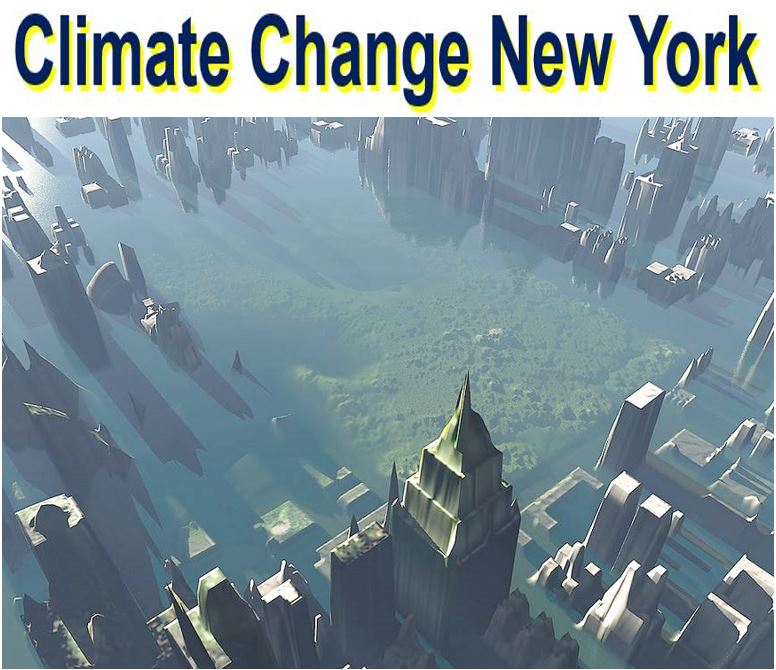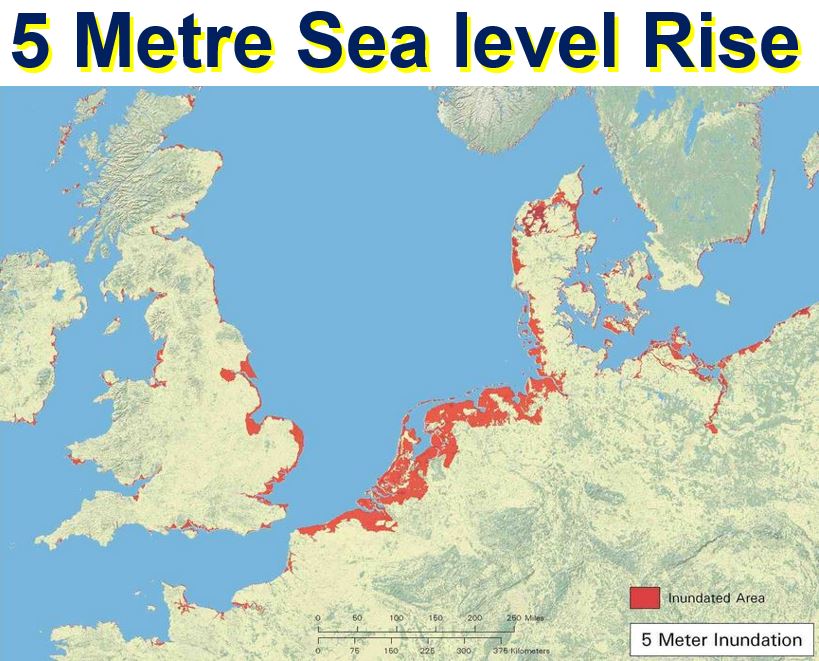Climate change devastation, including rising sea levels and killer storms that could wipe out hundreds of cities globally, will probably be much worse than reported estimates, and will hit us much sooner than we realise, says an international team of scientists.
In an article published in the scientific journal Atmospheric Chemistry and Physics (citation below), James E. Hansen, a Director at Columbia University, and colleagues from the USA, France, China and Germany, warn that ‘killer storms’, rising sea levels and the ‘disintegration’ of major parts of the polar ice sheets will occur much earlier than thought.
 London, the heart of Britain’s economy and Europe’s major financial centre, would be devastated. Imagine the economic and human cost to the city when sea levels rise. Dozens of important European cities would also be severely affected, including Amsterdam, Rotterdam, Barcelona, and Hamburg. (Image: inhabitat.com)
London, the heart of Britain’s economy and Europe’s major financial centre, would be devastated. Imagine the economic and human cost to the city when sea levels rise. Dozens of important European cities would also be severely affected, including Amsterdam, Rotterdam, Barcelona, and Hamburg. (Image: inhabitat.com)
We are near ‘point of no return’
Our current rate of fossil-fuel burning and greenhouse gas emissions are rapidly taking us past the ‘point of no return’ regarding an eminent climate shift. In other words, we are nearing a point after which there is nothing we can do, the climate change process will continue regardless.
In the Paper, the authors wrote:
“Humanity is rapidly extracting and burning fossil fuels without full understanding of the consequences. Current assessments place emphasis on practical effects such as increasing extremes of heat waves, droughts, heavy rainfall, floods, and encroaching seas.”
Lead author, climate scientist Dr. Hansen, who used to work for NASA, said regarding future generations and young people today:
“We’re in the danger of handing young people a situation that’s out of their control.”
 New York City, another major financial centre, would also become virtually uninhabitable. Several other major cities in North America, including Miami, Vancouver, Jacksonville, Virginia Beach, Sacramento, Boston, New Orleans, and dozens more would need to be evacuated. (Image: oceanleadership.org)
New York City, another major financial centre, would also become virtually uninhabitable. Several other major cities in North America, including Miami, Vancouver, Jacksonville, Virginia Beach, Sacramento, Boston, New Orleans, and dozens more would need to be evacuated. (Image: oceanleadership.org)
Sea levels will rise sooner than expected
Most scientists agree that when the polar ice melts, sea levels will rise considerably, possibly by as much as twenty to thirty feet. The debate among those in the scientific community has been regarding ‘when’ it will happen rather than ‘if’ – some say within decades while others insist the devastation is centuries away.
According to this latest study, sea levels will rise to these devastating levels within the next half century, i.e. by 2066.
In a video explaining the paper (below), Dr. Hansen said that this would mean the loss of several large cities across the world, plus all their history.
Dr. Hansen and fellow authors believe the process of rising sea levels will accelerate as soon as freshwater from melted ice sheets forms a cap on the surface of the ocean.
The cap will prevent warmer water from spreading, it will also stop some of the warmth from escaping into the atmosphere. The accumulated warmth in those waters will then speed up the melting of parts of the ice sheets which lie below sea level.
 The red areas represent parts of north-west Europe that would be flooded following a 5-metre (16.4 feet) sea level rise. Imagine what a 9-metre (29.5 feet) increase would do. (Image: antarcticglaciers.org)
The red areas represent parts of north-west Europe that would be flooded following a 5-metre (16.4 feet) sea level rise. Imagine what a 9-metre (29.5 feet) increase would do. (Image: antarcticglaciers.org)
The scientists base their predictions on storms that happened about 120,000 years ago, when average global temperatures were only marginally higher than they are now.
The authors wrote in an Introduction of the Paper:
“These assessments and our recent study conclude that there is an urgency to slow carbon dioxide (CO2) emissions, because the longevity of the carbon in the climate system and persistence of the induced warming may lock in unavoidable, highly undesirable consequences.”
Citation: “Ice melt, sea level rise and superstorms: evidence from paleoclimate data, climate modeling, and modern observations that 2 °C global warming could be dangerous,” James Hansen, Kwok-Wai Lo, Makiko Sato, Paul Hearty, Reto Ruedy, Maxwell Kelley, Pushker Kharecha, Allegra N. Legrande, Valerie Masson-Delmotte, Gary Russell, George Tselioudis, Junji Cao, Evgeniya Kandiano, Karina von Schuckmann, Eric Rignot, Isabella Velicogna, Blair Tormey, Bailey Donovan & Michael Bauer. Atmospheric Chemistry and Physics. 22 March, 2016. DOI: 10.5194/acp-16-3761-2016.
Video – Dr. Hansen talks about the latest Paper
In this video, Dr. Hansen talks about the ‘point of no return’, in which we lock in consequences that cannot be reversed on any time scale that people care about. It appears we are much closer to this point than anybody realised.
